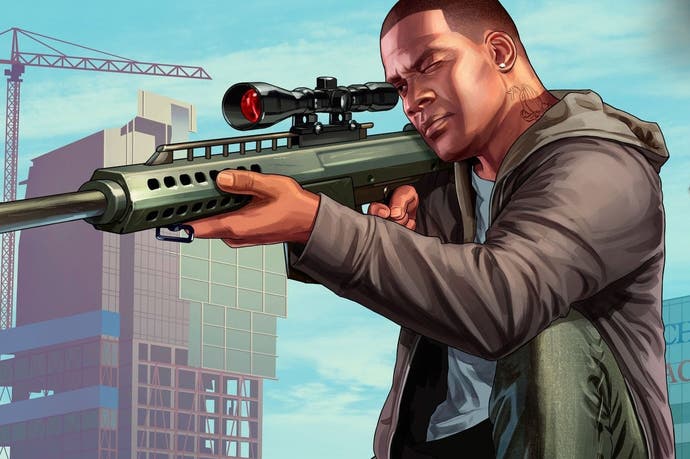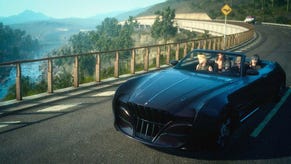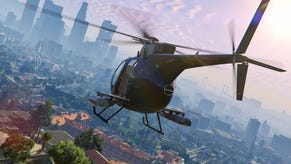Face-Off: Grand Theft Auto 5 on PS4 and Xbox One
Remaster class.
Putting foliage differences aside for a moment, it's clear Rockstar Games' tentpole release emerges on PS4 and Xbox One with visual enhancements aplenty. Both versions push for an ambitious 1920x1080 framebuffer this time, even adding in a first person mode to invite closer scrutiny of Los Santos' finer details. The confidence is well founded too, with updated textures and new effects in place - but do both consoles qualify for the equal treatment, or does the PS4 advantage go beyond its extra woodland flourishes?
As tested on the latest patch 1.02, this updated Grand Theft Auto 5 is obviously more than a simple resolution bump, though that's a fine start. The 1080p resolve is backed by higher-grade post-processing AA, flattering the game's more generous allowance for draw distance. Horizon details are easier than ever to pick out here, and trekking through Rockstar's pastiche of Los Angeles no longer produces the obvious pop-in artifacts of the last-gen releases. The switchover is still there, but for both PS4 and Xbox One, objects now draw in at the same impressive, far-flung range.
For any massive sandbox world, the surplus of RAM on these new machines is a vital resource. Here we see the Rage engine is no longer beholden to streaming all assets from the optical media and HDD caches - and the GPUs on each unleash the potential for more effects. On PS4 and Xbox One alike, we now get focal effects such as depth of field (DOF), god rays, and also screen-space reflections across glossy floors. It's still a last-gen game at its core, but the extra finesse here makes it hard to go back a generation - and neither Sony or Microsoft's new hardware misses out.
We've pieced together a lengthy head-to-head video below, slowing the footage down to 33 per cent to better allow these details soak in without YouTube's sometimes suspect image quality. The overwhelming takeaway is that sides of the divide are mostly identical throughout, though as ever, there are exceptions to the rule.
This is, of course, in reference to the foliage cutbacks on Xbox One. As bullet-points in a Face-Off comparison go, we're surprised to find this is in fact the biggest for Grand Theft Auto 5's re-release. The Xbox One version is hardly a barren landscape when taken in isolation, but placed side-by-side with the PS4's woodlands and deserts, it's clear there are distinct contrasts in vegetation density. Some areas are entirely unaffected, but at its most apparent we have grass tufts and ferns stripped from the game world - as shown in one overview of the O'Neil farm.
However, it's fair to say this isn't something which impacts the enjoyment of the Xbox One game; rather, it's a bonus on paper for PS4 owners, but one that players are unlikely to register during play. And to be clear, this affects smaller plant-life only, and no likewise cutbacks are in place on Microsoft's platform for larger flora - larger environmental blocks such as trees and cacti being rooted to the exact same spots across the world.
Also common to both consoles is texture quality, with refreshed maps plastered across each highway and skyscraper. From the fabric of Michael's winter jacket to the pebble-stone lining of his garden, each surface gets at least a tiny ramp-up in map resolution, or better yet, the use of parallax occlusion mapping to really bring an object's form to life. Trees now twist and gnarl visibly - where before their outline was a flat line - and brick walls around villas now pop outwards.


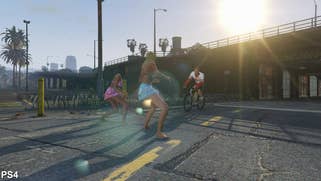
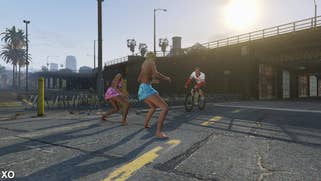

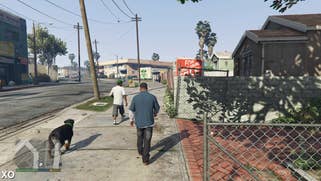



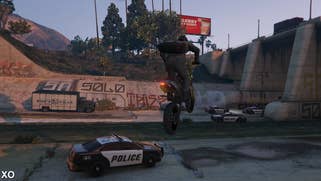
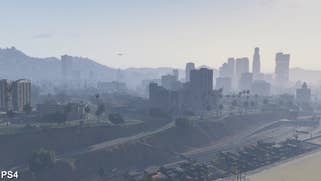



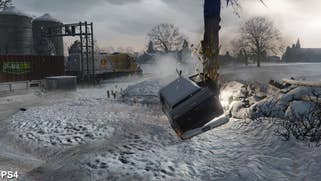
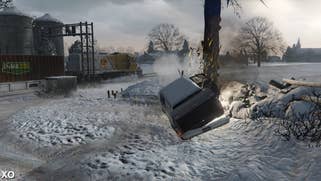
It's a success story for both PS4 and Xbox One, but one disappointment remains: texture filtering. Though a step ahead of the last-gen standard, the effect is equally sub-par on both platforms in its current state. The perceived effect is an unwanted trail-off to texture detail when seen at a angle, with a blur creeping in near the player's field of view when walking down streets.
As rough edges go, the approach to shadow filtering is also a surprising snag. Having Franklin pace outside his house in broad daylight shows this at play; a cascade runs ahead of the camera, sweeping across blurred shadows to reveal a higher quality iteration. It's a crude, binary switch that occurs much too close to the player's line of sight in this case - the switchover distance being the exact same on PS4 and Xbox One.
The lighting itself is much improved though, with a more nuanced volumetric lighting system adding bloom to character skin, and more gradual tones of shade across plant-life. God rays trail past buildings at sunset, and wide, anisotropic lens flares are added across car headlights too. One curious twist, however, is that the PS4 makes more aggressive use of lens flare in some scenarios compared to its Xbox One counterpart, even in matched lighting conditions. Next to the foliage differential, this counts in as a relatively minor cutback for Microsoft's platform, though one we notice recurring across our hours of capture.
Tying all these extra visual updates together is a novel camera setting; the first-person mode. At its best, we see Los Santos vivified to amazing effect; the new, sharper texture details are given a chance to shine, and vehicle dashboards are now fully fleshed out for 1:1 handling of the wheel. A whiff of camera latency makes movement more sluggish than is expected of this perspective, however, even compared a typical 30fps shooter - this being our main gripe, alongside the ineffective rear-view mirrors in cars. But even so, it's fully playable, and confidently puts a spotlight on the new details strewn across Rockstar's world.

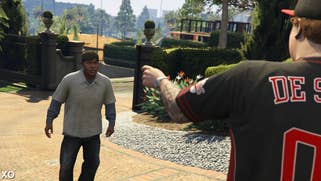


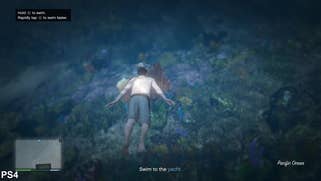
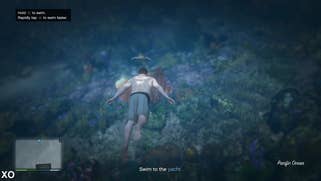

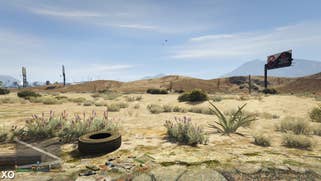
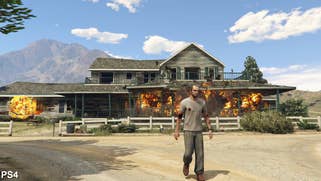
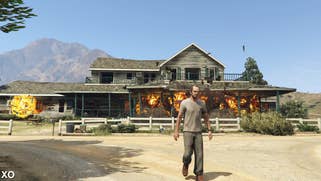

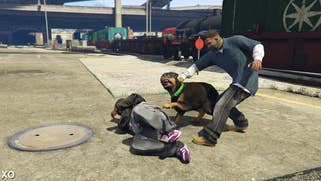


Given Xbox One and PS4's near-identical visual setups, you'd expect some margin of victory in performance for Sony's more powerful platform. Targeting a fully v-synced 30fps, it's worth stressing that both consoles are, in the end, surprisingly adept at holding form. An initial hour-long play-test, for example, flags no substantial dips on either console, and only the odd dropped frame interrupts a usually perfect 30fps line. It's a solid performer regardless of which flag you fly.
But once we venture on to later missions, certain buckling points start appearing on each console. For the PS4, this often manifests during speed races through busy downtown junctions, where a drop to 24fps constitutes our biggest performance dip. In running a time-lapse comparison of these grid-locked areas, it's interesting to learn traffic patterns are indeed identical for both platforms - the density of active vehicles is matched for both PS4 and Xbox One, so the Microsoft console's advantage here is probably down to its faster CPU cores. Xbox One, meanwhile, suffers from drops around heavier traffic, but typically to a lesser extent than its PS4 stablemate. The downside for Microsoft's more GPU-restricted platform is in a different area entirely meanwhile; namely, the console's handling of transparency effects such as explosions or water sprays.
Where Sony's hardware soars through one explosive shoot-out with a drug cartel, with its strong 30fps line, the Xbox One picks a rougher path through its prolonged 24-26fps read-out. This may be down to the strain on Microsoft's GPU memory bandwidth in upholding a 1920x1080 output, but adding an excess of alpha effects - which otherwise go toe-to-toe with the PS4's level of effects quality - makes a bottleneck evident here.
Alternative analysis:
Grand Theft Auto 5 on PS4 and Xbox One - the Digital Foundry verdict
Technically, Grand Theft Auto 5 for PS4 and Xbox One is an unmistakable product of last-gen design, but its re-release finesses the visuals enough to make Los Santos well worth revisiting. Both consoles receive even-handed treatment from Rockstar North, starting with the 1080p setup on each, and leading to the boosted texture resolution and broadened draw distances. Given the markdown in foliage density on Xbox One, we're surprised traffic shows no likewise downgrade around the city centre for the console - and that additions such as parallax occlusion mapping and screen-space reflections remain intact.
All of which means the PS4 advantage is based on its higher foliage density, plus its more intense lens flare effect. Otherwise, the visual comparisons and performance metrics paint both versions in a positive light; the 30fps target not being a perfect lock on either, but much improved over last-gen despite the enhancements elsewhere. On balance, at stress points the PS4 wins out on this front; despite dipping further in our racing sequences, the console has no trouble tackling alpha-heavy shoot-outs. On the other hand, the Xbox One betrays its weakness in both scenarios, albeit to a differing extent for the driving sections.
With the PC release set for release on 27th January next year, the prospect of further enhancements on more powerful setups is appetising indeed - especially the allure of playing at a full 60fps. But the good news here is that both console versions deliver a satisfying rendition of an existing classic, making it an adventurous - if largely like-for-like - experience for owners of either PS4 or Xbox One. As for comparisons with last year's PS3 and Xbox 360 releases, we aim to show the drastic effects of Rockstar's re-tune of Los Santos in an upcoming cross-gen showdown.
